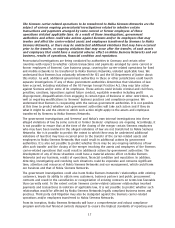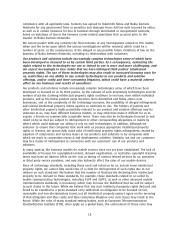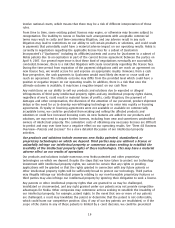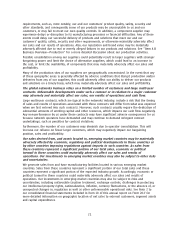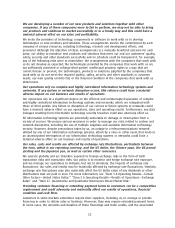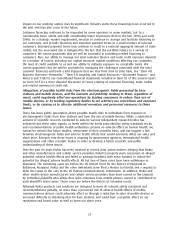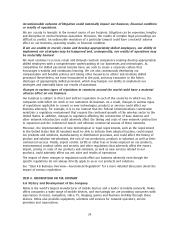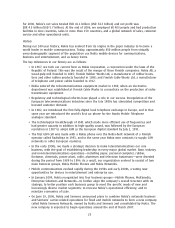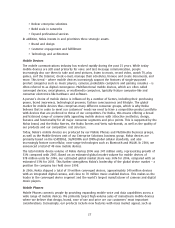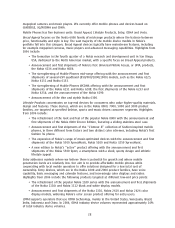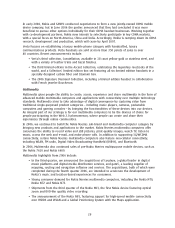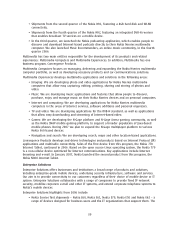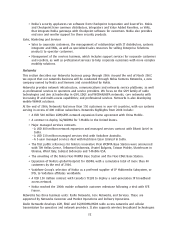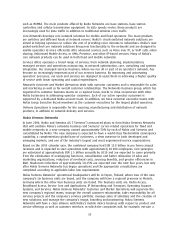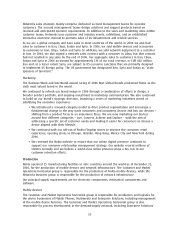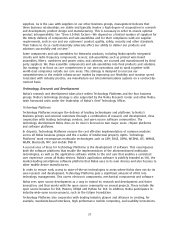Nokia 2006 Annual Report Download - page 28
Download and view the complete annual report
Please find page 28 of the 2006 Nokia annual report below. You can navigate through the pages in the report by either clicking on the pages listed below, or by using the keyword search tool below to find specific information within the annual report.)Deliver enterprise solutions
)Build scale in networks
)Expand professional services
In addition, Nokia invests in and prioritizes three strategic assets:
)Brand and design
)Customer engagement and fulfillment
)Technology and architecture
Mobile Devices
The mobile communications industry has evolved rapidly during the past 15 years. While today
mobile devices are still used primarily for voice and text message communication, people
increasingly also use them to take and send pictures, listen to music, record video, watch TV, play
games, surf the Internet, check email, manage their schedules, browse and create documents, and
more. This trend – where mobile devices increasingly support the features of singlepurposed
product categories such as music players, cameras, pocketable computers and gaming consoles – is
often referred to as digital convergence. Multifunctional mobile devices, which are often called
converged devices, smartphones, or multimedia computers, typically feature computerlike and
consumer electronicslike hardware and software.
A person’s choice of mobile device is influenced by a number of factors, including their purchasing
power, brand awareness, technological prowess, fashion consciousness and lifestyle. The global
market for mobile devices thus comprises many different consumer groups, which is why Nokia
believes that in order to meet our customers’ needs we need to have a competitive product portfolio
with devices that are preferred to those of our competitors. For Nokia, this means offering a broad
and balanced range of commercially appealing mobile devices with attractive aesthetics, design,
features and functionality for all major consumer segments and price points. This is supported by the
Nokia brand, and the Nokia Nseries, the Nokia Eseries and Vertu subbrands, as well as the quality of
our products and our competitive cost structure.
Today, Nokia’s mobile devices are produced by our Mobile Phones and Multimedia business groups,
as well as the Mobile Devices unit of our Enterprise Solutions business group. Nokia devices are
primarily based on the GSM/EDGE, 3G/WCDMA and CDMA global cellular standards, and also
increasingly feature noncellular, nearrange technologies such as Bluetooth and WLAN. In 2006, we
announced a total of 49 new mobile devices.
The total mobile device volume of Nokia during 2006 was 347 million units, representing growth of
31% compared with 2005. Based on an estimated global market volume for mobile devices of
978 million units for 2006, our estimated global market share was 36% for 2006, compared with an
estimated 33% for 2005. This further strengthens Nokia’s leadership of the global device market – a
position the company has held since 1998.
In 2006, Nokia shipped a total of 39 million converged devices, approximately 140 million devices
with an integrated digital camera, and close to 70 million music enabled devices. This makes us the
leader in the converged device segment and the world’s largest manufacturer of cameras and digital
music players.
Mobile Phones
Mobile Phones connects people by providing expanding mobile voice and data capabilities across a
wide range of mobile devices. We primarily target highvolume sales of mainstream mobile devices
where we believe that design, brand, ease of use and price are our customers’ most important
considerations. Increasingly, our products include new features with mass market appeal, such as
27


